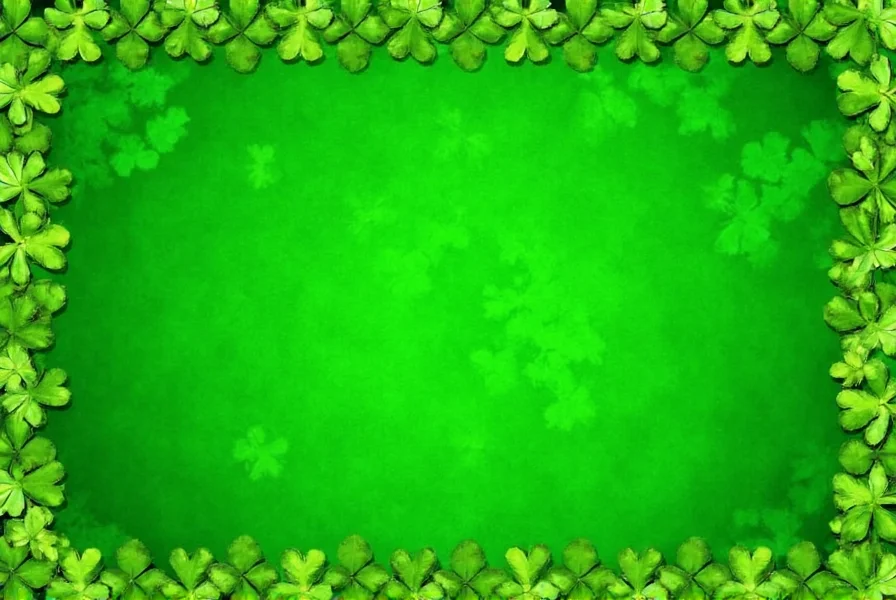Clover backgrounds have become increasingly popular across multiple design applications due to their versatile symbolism and visual appeal. Whether you're creating St. Patrick's Day marketing materials, nature-themed presentations, or seeking subtle decorative elements for digital projects, understanding the different types and applications of clover backgrounds can significantly enhance your design outcomes.
Types of Clover Backgrounds
Clover backgrounds come in various styles, each serving different design purposes. The most common variations include:
| Type | Best For | Visual Characteristics |
|---|---|---|
| Subtle Pattern | Professional documents, websites | Faint, repeating clover motifs with low opacity |
| Vibrant Field | Holiday promotions, festive designs | Bright green clovers covering entire background |
| Four-Leaf Variant | Luck-themed projects, special occasions | Features rare four-leaf clovers as focal points |
| Watercolor Style | Artistic projects, invitations | Soft, blended clover illustrations with texture |
Practical Applications of Clover Backgrounds
Clover backgrounds serve multiple purposes across different mediums. Understanding where and how to use them effectively can transform your design projects from ordinary to exceptional. For digital designers seeking nature-inspired background templates for websites, clover patterns provide organic texture without overwhelming content.
Event planners frequently utilize St. Patrick's Day themed backgrounds with clover motifs for invitations, social media graphics, and venue decorations. The symbolism of luck and prosperity associated with clovers makes them particularly effective for promotional materials during March celebrations.
Interior designers sometimes incorporate clover patterns into printable clover background templates for wall decals, creating subtle thematic elements in spaces where luck and nature symbolism are desired. The repeating pattern works well for creating visual interest without becoming distracting.
Technical Considerations for Quality Results
When selecting or creating a clover background, several technical factors determine its effectiveness:
- Resolution requirements - For digital use, 72 DPI is sufficient, while print materials require at least 300 DPI
- File format selection - PNG for transparency needs, JPEG for photographs, SVG for scalable vector patterns
- Color scheme compatibility - Traditional green works for most applications, but consider monochromatic or complementary schemes for specific projects
- Pattern repeat quality - Seamless tiling prevents visible seams in repeating backgrounds
Designers searching for high-resolution clover background images for professional projects should verify these technical specifications before implementation. Poor quality backgrounds with pixelation or visible seams immediately reduce the perceived professionalism of any project.
Cultural Significance and Symbolism
The clover carries rich symbolism across various cultures, which influences its effectiveness as a background element. The three-leaf shamrock represents the Holy Trinity in Christian tradition and is strongly associated with Irish heritage. The rare four-leaf clover symbolizes luck, with each leaf representing hope, faith, love, and luck.
When creating symbolic clover background designs for meaningful projects, understanding these cultural associations helps ensure appropriate usage. For example, using four-leaf clover backgrounds for wedding invitations carries different connotations than using them for corporate branding.
Where to Find Quality Clover Backgrounds
Several reputable sources offer clover backgrounds for various applications:
- Free design resource platforms with proper licensing for personal and commercial use
- Stock image websites with advanced filtering for specific clover styles
- Design communities where artists share pattern templates
- Specialized nature-themed design resource sites
When searching for free downloadable clover background patterns with commercial license, always verify the usage rights. Many free resources require attribution or restrict commercial applications. Premium resources often provide higher quality files with more flexible licensing options.
Design Integration Best Practices
Successfully incorporating clover backgrounds requires thoughtful implementation:
- Ensure sufficient contrast between background and foreground text/content
- Use lower opacity for backgrounds that will contain text overlays
- Consider the psychological impact of green tones on your audience
- Test backgrounds across multiple devices and screen sizes
- Avoid overly complex patterns that distract from primary content
For those creating minimalist clover background designs for professional presentations, remember that less is often more. A subtle pattern in the background can reinforce your theme without competing for attention with your main content.
Common Implementation Mistakes
Even experienced designers sometimes make these errors with clover backgrounds:
- Using overly bright green that causes eye strain
- Selecting patterns with visible seams in repeating elements
- Choosing backgrounds that don't align with the project's overall theme
- Ignoring accessibility considerations for text readability
- Using low-resolution images that appear pixelated on modern displays
Designers searching for accessible clover background options for inclusive design should prioritize sufficient color contrast and avoid patterns that might trigger visual discomfort for sensitive viewers.
Creating Custom Clover Backgrounds
For unique projects, creating a custom clover background ensures perfect alignment with your design vision. The process involves:
- Selecting or creating your clover motif
- Determining the appropriate scale and spacing
- Choosing a color palette that complements your project
- Creating a seamless repeat pattern
- Testing the background with your actual content
Those interested in DIY clover background creation for personal projects can use vector design software to create scalable patterns that maintain quality at any size. Even basic design tools offer sufficient functionality for creating simple repeating patterns.
Conclusion
Clover backgrounds offer versatile design possibilities when implemented thoughtfully. By understanding the different types, technical requirements, and symbolic meanings, you can select or create backgrounds that enhance rather than detract from your primary content. Whether you're searching for ready-to-use clover background templates for immediate projects or planning to create custom designs, attention to quality and appropriate usage will yield the best results.











 浙公网安备
33010002000092号
浙公网安备
33010002000092号 浙B2-20120091-4
浙B2-20120091-4